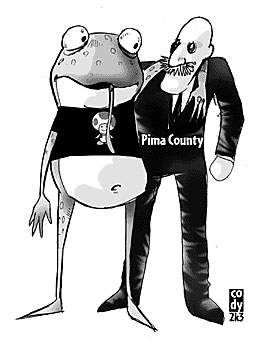
Illustration by Cody Angell
|
|
By Sabrina Noble
Arizona Daily Wildcat
Thursday, September 25, 2003
Drainage around Tucson inconveniences drivers in rainy weather and we all complain about rush-hour traffic in a city that could certainly use better planning. But for some species, such as our little hopping friend the toad, the rains and roads mean even more dangerous travel.
Monsoon season is a rough time for Tucson-area toads. All they want to do is feed and breed when the rains come, but Speedway Boulevard runs between where they live and where they mate. That means leapfrogging it across a busy road and ÷ no offense to toads ÷ judging by the number of bodies turned up by National Park Service surveys, they clearly don't have the mental capacity to look both ways. Hundreds of Couch's spadefoot, red-spotted and Colorado River toads die on Speedway each year during the monsoon season. What should be a life-giving season becomes one full of fatalities for these species due ÷ once again ÷ to human development.
But in the case of the toad, humans now might also be the source of salvation. In a move that we all should know about ÷ for the interesting trivia, if nothing else ÷ Pima County is seeking to cut down on reptilian road kill by constructing tunnels beneath the boulevard. A large box culvert and several smaller pipe culverts at "high traffic" toad crossings will serve as northern passages for toads as well as other animals that might otherwise meet an untimely end with a pickup truck.
Cool. But what does it cost?
The county is requesting a $500,000 federal grant to do this and, if the funds are granted, the county Transportation Department will contribute $125,000 of its own to match. So the county, amidst all sorts of other traffic and environmental problems, would spend $625,000 on toad underpasses.
Establishing a safe way for dwindling species to cross the road is a great idea in theory. However, if toads aren't clever enough to make it across the road, why will they decide to stick to an underground passageway? The county will help them with an 18-inch barrier meant to guide them into the tunnels and keep them out of the road, but no one knows if the toads will pay attention. And when it's pouring outside, won't the tunnels flood like everything else around here? Will they fill with dirt, creating constant maintenance expenses? Or perhaps the tunnels will attract predators that will take out even more toads and small animals than motor vehicles.
Protecting animals, even the lowliest of creatures, should be a top priority. This is especially true in the Southwest desert, which is one of the most ecologically diverse areas in the country. But is federal grant money really best spent on digging beneath Speedway? While toads are vital to the ecosystem, none of the three affected toad species are endangered.
Yes, some die on their way across the road, but there are certainly endangered species that have a greater need for federal preservation grant funding.
But perhaps more important and far-reaching than tunnels and grant money are the effects of human encroachment on natural habitats. First, we pay to build the roads. Then we pay to protect the animals those roads negatively affect. The toad tunnels are just one more example in a long history of making inadequate concessions to the environment.
Tucson is not the only city taking steps to atone for its shortsightedness. In Brentwood, Calif., people are now building "frog condos" for the California red-legged frog, which has been declared a threatened species by the U.S. Fish and Wildlife Service because of grazing, reservoirs and housing. They've built 34 wooden frog shelters. The builders have no idea whether any frogs will move in, but if they build little houses, they won't have to feel so bad about when they collected hundreds of thousands of red-legged frogs from 1890 to 1990 ÷ when restaurants served them as a delicacy. Hopefully the rescue mission won't be too little, too late, but if it is, it won't be the frogs' fault.
Pima County has noble intentions, but federal grant money would be better spent where it's sure to make a difference ÷ and the county's time and effort in the future would be better spent on looking out for the environment before the concrete has set, not after. Otherwise, we're simply working to make up for ourselves.
Sabrina Noble is a senior majoring in English and creative writing. She can be reached at letters@wildcat.arizona.edu.

